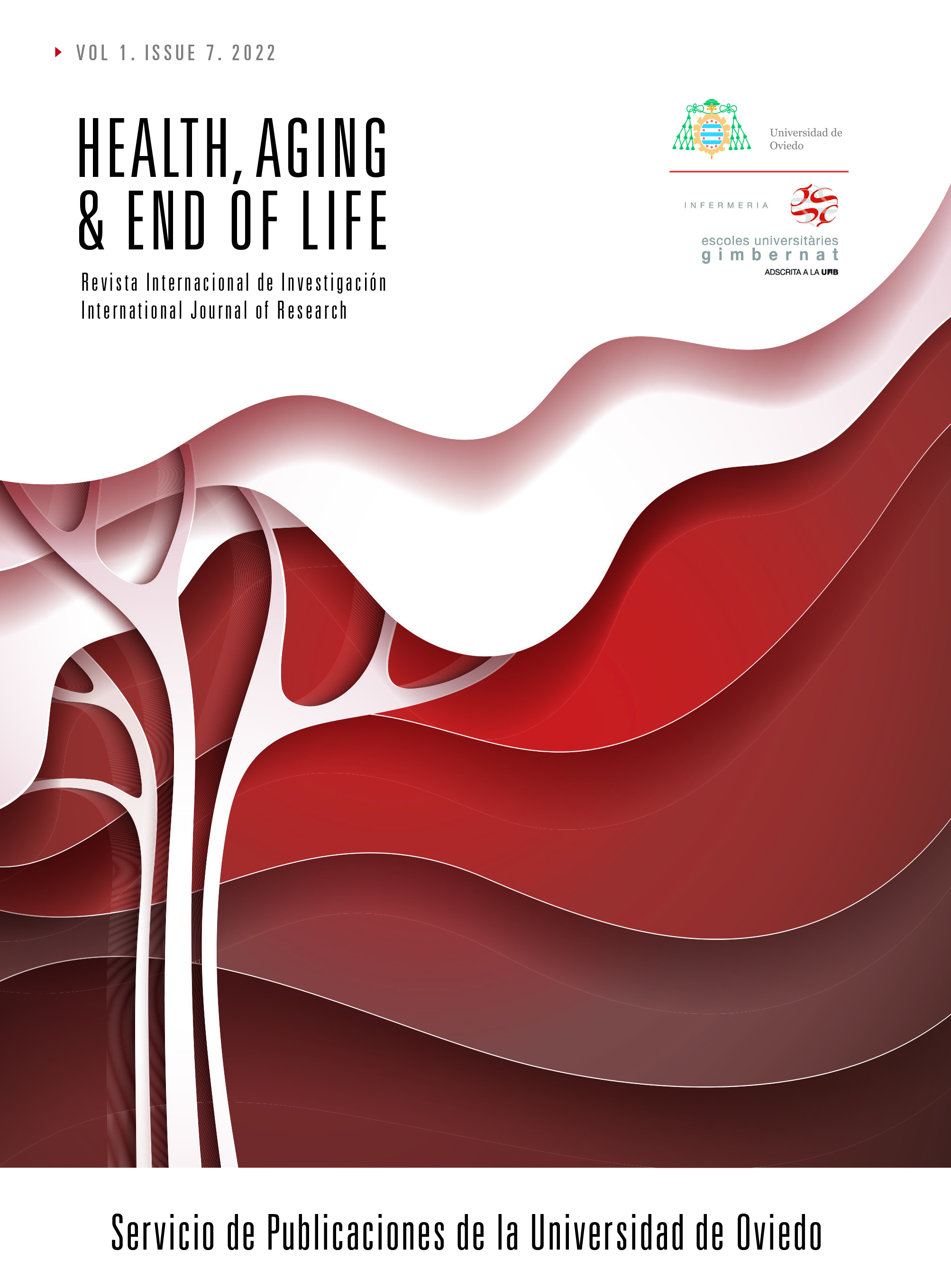Abstract
The term end of life is widely used in the scientific literature but lacks a definition that accurately identifies those signs which appear in that situation of last days which precedes death and to whom is incorporated the most prevalent item employed in those prognostic models in cancer disease, such as functionality.Terminal illness and dying make up a process suffered by the sick person but also by the family, which is a basic pillar in provision of care to the patient. A descriptive and exploratory review is made of the meanings about the scientific english literature uses when refers to end of life, of the different patterns of death that present into distinct diseases; of the most used items in prognostic scales, already validated, in cancer, and finally the more frequent used drugs in a situation of imminent end of life. Identification an end of life allows us to use some medicines, at a higher doses than before and through an oral alternative route, the subcutaneous, which permits the control of symptoms that appear in this end-of-life situation to thus facilitate the death of the dying person with family, and relatives, over there. This paper tries to minimize the problem of identifying a person actively dying in which keys are given for its recognition and treatment, not only pharmacological, which can be of interest to all those professionals who face the end of life of any person in this circumstance.
References
Alonso, A., Vilches, Y., & Díez, L. (2008). Atención en la agoníaa. Psicooncología, 5(2), 279-302.
Álvarez Colorado, M., Amoedo Albero, M. C., & Cano Tébar, A. M. Gandía
Herrero M García Verde I, Gil Lopez J, et al. Guía de recomendaciones prácticas. Uso de la vía subcutánea de la práctica centrada en la enfermedad a la atención centrada en el paciente. Martínez Cruz MB. Coordinadora. Madrid: IM&C; 2021.
Bruera, E. Macmillan, K. Pither, J. MacDonald, R.N. (1990). Effects of morphine on the dyspnea of terminal cancer patients. J Pain Symptom Manage, Dec;5(6):341-4.
Cambridge Dictionary. (16 de Julio de 2022). Agony. https://dictionary.cambridge.org/es/diccionario/ingles-espanol/agony
Coyle, N., Adelhardt, J., Foley, K. M., & Portenoy, R. K. (1990). Character of terminal illness in the advanced cancer patient: pain and other symptoms during the last four weeks of life. Journal of pain and symptom management, 5(2), 83-93.
Cherny, N. I., & Portenoy, R. K. (1994). Sedation in the management of refractory symptoms: guidelines for evaluation and treatment. Journal of palliative care, 10(2), 31-38.
De La Guía, G. D. T. (2008). de Práctica Clínica sobre Cuidados Paliativos. Guía de Práctica Clínica sobre Cuidados Paliativos. Madrid: Plan Nacional para el SNS del MSC. Agencia de Evaluación de Tecnologías Sanitarias del País Vasco, 48.
Gómez-Sancho, M., Altisent, R., Bátiz, J., Ciprés, L., Corral, P., González-Fernández, J.L., Herranz, J.A., Rocafort, J., & Rodríguez-Sendín, J.J. (2010). Atención médica al final de la vida: Conceptos. Revista de la Sociedad Española del Dolor, 17(3), http://scielo.isciii.es/scielo.php?script=sci_arttext&pid=S1134-80462010000300007&lng=es&tlng=es.
Graeff, A. D., & Dean, M. (2007). Palliative sedation therapy in the last weeks of life: a literature review and recommendations for standards. Journal of palliative medicine, 10(1), 67-85.
Guía de Sedación Paliativa. Observatorio Atención Médica al final de la vida. (2021). (consultado el 6/04/2022). Ed: OMC. Consejo General de Colegios Oficiales de Médicos (CGCOM). SECPAL. En: https://www.cgcom.es/sites/default/files/guia_sedaccion_paliativa.pdf,
Guía de Sedación Paliativa. Observatorio Atención Médica al final de la vida. (2021). (consultado el 6/04/2022). Ed: OMC. Consejo General de Colegios Oficiales de Médicos (CGCOM). SECPAL. En: https://www.cgcom.es/sites/default/files/guia_sedaccion_paliativa.pdf,
Hughes, A., Wilcock, A., Corcoran, R., & Lucas, V. (2000). Audit of three antimuscarinic drugs for managing retained secretions. Palliative medicine, 14(3), 221. https://doi: 10.1191/026921600670188257.
Hui, D., Nooruddin, Z., Didwaniya, N., Dev, R., De La Cruz, M., Kim, S. H., ... & Bruera, E. (2014). Concepts and definitions for “actively dying,”“end of life,”“terminally ill,”“terminal care,” and “transition of care”: a systematic review. Journal of pain and symptom management, 47(1), 77-89.
Kirk, T. W., & Mahon, M. M. (2010). Palliative Sedation Task Force of the National Hospice and Palliative Care Organization Ethics Committee. National Hospice and Palliative Care Organization (NHPCO) position statement and commentary on the use of palliative sedation in imminently dying terminally ill patients. J Pain Symptom Manage, 39(5), 914-923.
Menten, J., & Hufkens, K. (2004). Objectively observable signs of imminently dying in palliative patients. In Abstract of the 3rd Research Forum of the European Association for Palliative Care. Palliat Med (Vol. 18, No. 4, p. 351).
Morita, T., Akechi, T., Sugawara, Y., Chihara, S., & Uchitomi, Y. (2002). Practices and attitudes of Japanese oncologists and palliative care physicians concerning terminal sedation: a nationwide survey. Journal of Clinical Oncology, 20(3), 758-764.
Nauck, F. Klaschik, E. Ostgathe, C. (2000) Symptom control during the last three days of life. Eur J Palliative Care,7;81-4. Oxfordlearnersdictionaries. (16 de Julio de 2022). Agony. https://www.oxfordlearnersdictionaries.com/definition/english/agony?q=agony
Real Academia Española. (actualizado 2020). Agonía. En Diccionario de la Lengua Española. Recuperado en 10 noviembre 2021 de https://dle.rae.es/agon%C3%ADa?m=form
Roy, D. J. (2005). Euthanasia and withholding treatment. Oxford Textbook of Palliative Medicine. Third. Oxford, 84-97.
Sales, J. P., Olarte, J. M. N., Trota, R. A., Aguilar, A. G., Loncán, P., Sánchez, J.M., ... & Ortiz, J. S. (2002). Aspectos éticos de la sedación en Cuidados Paliativos. Medicina paliativa, 9(1), 41-46.
Santos Suárez, J. (2022). Reflexiones sobre la agonía. Medicina Paliativa, 29(1), 56-57.
Soriano Fernández, H., Rodenas García, L., Moreno Escribano, D., Roldán Castillo, B., Castaño Moreno, E., & Palazón García, E. (2009). Utilización de la vía subcutánea en atención primaria. Revista Clínica de Medicina de Familia, 2(8), 426-433.
Wiffen, P. (2015). Palliative Care Formulary 5th edition,22:182.

